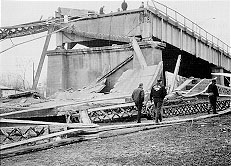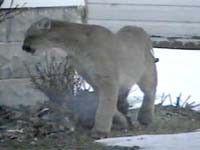
August 5, 2007
Things fall down. People look up. And when it rains, it pours.Magnolia, 1999.

The collapse of the I-35W bridge in Minnesota is a tragedy, some say of epic proportions. Certainly, it is the most significant bridge collapse, not caused by an easily visible external reason like an earthquake or an impact from a barge, since 1967.
An Anomaly
National Transportation Safety Board Chairman Mark Rosenker said it is too early for officials to know if the accident could have been avoided. “They are built not to fall down. This is an anomaly and we’re going to try to find out why this is an anomaly and prevent that anomaly from ever happening again” he said in an appearance on ABC’s “Good Morning America” on August 3, 2007.
Rosenker’s use of the word “anomaly” is intriguing. Bridge collapses are unexpected events of the eventually expected (if no one fixes decaying bridges). But officialdom works in a political world of being publicly surprised by the predictable probable incidents of tomorrow.
My liveliest interest is not so much in things, as in relations of things. I have spent much time thinking about the alleged pseudorelations that are called coincidences. What if some of them should not be coincidences?Charles Fort, Wild Talents.

The Silver Bridge
For those noticing the overlaps in horror between the Silver Bridge collapse and the I-35W Bridge, the links between the two are apparent. It does seem strange they both were on highways designated with the number 35. Likewise, the reaction to both events has been large and understandable. In 1967, after the Silver Bridge fell, bridge inspections ordered by President Lyndon Johnson, never before done in the United States in any coordinated fashion, were begun because of the Silver Bridge incident.
Today, we talk about the Silver Bridge, the Eyebar #13 cause of the collapse, and Mothman, all in the same breath. But in the days after December 15, 1967, the news of bodies and vehicles that had been swept far down the Ohio River was in the media daily. List of survivors and their stories filled the papers in the same way as the features are nonstop on the television news channels today.

Forty-Six Deaths
The deaths resulting from the I-35W Bridge falling does not include any of the people I know in the Minneapolis-St. Paul area, and those colleagues and friends have checked in with me and others. That’s good. Not so good, people did die and some are still missing.
The known I-35W dead includes these five people:
Sherry Engebretsen, 60, of Shoreview;
Julia Blackhawk, 32, of Savage;
Patrick Holmes, 36, of Moundsview;
Artemio Trinidad-Mena, 29, of Minneapolis; and
Paul Eickstadt, 51, of Moundsview.
The Associated Press identified five of the missing (and presumed dead?), as:
Christine Sacorafas, 45, a recent transplant to Minnesota who was on her way to teach a Greek folk dancing class;
Greg Jolstad, 45, a construction worker who was operating a skid loader on the bridge;
Peter Hausmann, 47, a former missionary heading to pick up a friend; and
Somali immigrant Sadiya Sahal, 23, a pregnant nursing student traveling with her 2-year-old daughter, Hanah.
The police list also included Vera Peck and her 21-year-old son, Richard Chit, who were in the same car, and Scott Sathers, information unknown.
5 + 8 = 13.

After the Silver Bridge collapse, the funerals and obituaries were overwhelming. Forty-six people is a lot of individual remembrances and people touched in a relatively small rural area. The large death toll predictions of I-35W have not come to be, unless there is something we are not being told. The final death count could be in the range of 13 or so. Tragic, yes, but not the 50 or 100 people dead, as we first all heard.
I have talked elsewhere of the bizarre coincidences of a Reeves (one of the first people to arrive to help) and a McDaniel (the present mayor of Point Pleasant) being in the media in the wake of the I-35W collapse. My recent blog on the name game of I-35W’s Reeves and McDaniel can be found here.
The St. Anthony Bridge
The I-35W Bridge was not always known by that name. The span originally carried the name Bridge 9340 in the books of the state Department of Transportation, and before that it was called the St. Anthony Bridge.
Not too far from the bridge, overlooking the Mississippi River, is Minnehaha Park, located at the intersection of Hiawatha Avenue and Minnehaha Parkway. The popular 193-acre park features a 53-foot waterfall, limestone bluffs and river overlooks.
In 1680, the falls became known to the rest of the world when they were observed by Father Louis Hennepin, a Catholic friar of Belgian birth, who also brought the existence of Niagara Falls to the world’s attention. Hennepin named Saint Anthony Falls after his patron saint, Anthony of Padua (b. Lisbon, Portugal, 1195 – d. Padua, Italy, 1231), who named himself after the ancient St. Anthony. He is also remembered as the namesake for the city of San Antonio, Texas.
A mask of Taoyateduta, chief of the Mdewakanton Sioux, (in dismissive English, Chief Little Crow) is positioned near Minnehaha Falls. The mask commemorates the chief, who was killed in the year following the 1862 Dakota conflict, and is in an area considered to be sacred to American Indians. (Reminds me of the Curse of Chief Cornstalk.)
Nearby Highway 55 (Hiawatha Ave.) was once the main path Indians used to travel between the two falls located in Minneapolis: St. Anthony – the big falls, and Minnehaha – the little falls. Ironically, the I-35W Bridge, formerly St. Anthony Bridge, was, thus, the span of the “big falls.”
Zebulon Pike founded Fort Snelling (which became Minneapolis-St. Paul). This is Zebulon Montgomery Pike Jr. (January 5, 1779 – April 27, 1813), the American soldier and explorer for whom Pikes Peak in Colorado is named, not to be confused with his Revolutionary War officer-father, who was also known as Zebulon Pike. I-35W, thus, in essence, is also linked to the name Pike (another hot name in forteana circles).
Cryptologic or coincidence?
Jim Brandon should be credited with calling attention to the name Watts/Watkins/Watson, and its entanglement with inexplicable things. Some other names involved in mysterious events pinpointed by Brandon are Bell, Mason, Parsons, Pike, Vernon and Warren. The influence of such names as Mason, Pike, Warren, and Lafayette, for example, issues, in some cryptopolitical and occult way, from their ties to the Masonic tradition.Mysterious America.
But there is more. I-35W is a superhighway, with Waco at the southern USA end of I-35, as is San Antonio.
Jim Brandon, author of Weird America, emails and shares this with me today:
I could point out that the original 18th-century settlement that became Minneapolis, by French explorers Hennepin, Marquette and Nicollet (!!!), was at a point a few hundred yards upstream from the bridge called the Falls of St. Anthony. The ancient St. Anthony was the martyr who had been sorely afflicted by Satanic “temptations.”
But probably the most provocative cryptopolitical aspect, now in the day of the much-denied inauguration of the North American Union (Mexico + USA + Canada) is the so-called NAFTA Super Highway. This is known as North America’s Super Corridor Coalition Inc. or NASCO.
Jerome Corsi has been doing yeoman’s work covering this for months as you can see here, with an eye-popping graphic leading right up to Minneapolis [below].Jim Brandon.

NASCO states: “There are no plans to build a new NAFTA Superhighway — It exists today as I-35.”
Mothman and the Minneapolis Bridge
Once again, no Mothman was seen near the I-35W during the months leading up to the collapse of August 1st. None would be expected to have been seen there, at all. Coincidences do happen and weirdness reigns. But we talk about Mothman and winged weirdies frequently.
In the days before last Wednesday, Cryptomundo, for example, mentioned Mothman due to the anniversary of director Mark Pellington’s wife’s death on July 30th, the recent sightings of Big Birds around San Antonio, and the bizarre news of Mexican flying humanoids. Craig Woolheater’s mentions of Big Bird stories have been from the other end of I-35, from San Antonio. These were overviewed also by Jerome Clark back in 1978.
Reader Phyllis emailed that on the evening of July 31, 2007, “Coast to Coast AM” with George Noory had a guest who was talking about prophecies of tragic events and mentioned Mothman. The name of the program was “Fallen Angels & Biblical Prophecy,” with L. A. Marzulli, a researcher and student of ancient manuscripts who shared his insights on the Nephilim (fallen angels), biblical prophecy and the Apocalypse. Marzulli conjectured that anomalous creatures such as Mothman may have arrived through a portal. Well, I don’t know about that, but it is true, several of us talk about Mothman a great deal and not usually in an uplifting fashion (no pun intended).
Phantom Panthers

Willmar cougar, KSTP-TV.
The reality is, unlike Point Pleasant in 1966-1967, Minneapolis-St. Paul has not been involved in the midst of a flap of Big Bird, Thunderbird, Mothman, or strange animal reports before the bridge collapse. The most cryptic Minnesota event was the actual capture of a cougar exactly 16 months before the collapse, on February 1, 2006, at Willmar, Minnesota. Willmar is not too near Minneapolis.
Minnesota has had several reports of Phantom Panther (black panther and mountain lion-like) sightings down through the years, some in the green areas around Minneapolis. There’s nothing “banshee-like” about them, however.
The original and ancient St. Anthony had his problems with weird animals. According to Athanasius, the devil once resumed his war against Saint Anthony, and the phantoms were in the form of wild beasts, wolves, lions, snakes and scorpions.
Beyond Weirdness
After the I-35W fell and I blogged the same night on the subject of the Silver Bridge, a few in the media acknowledged Cryptomundo and my mention of the “flashback” that naturally occurred. Wired.com, Anomalist, and others were some of those sites.
The Plain Dealer in Ohio then discussed the impact in Point Pleasant.
Meanwhile, one conservative blogger decided to post this comment: “This bridge spanned the Ohio at Point Pleasant, W.Va., whose last claim to fame was the Mothman spoof that had local crazies gaining some national air time on the news.”
I’m not sure what that blogger is saying, but I’m certain he won’t be invited to speak at the next Mothman Festival.
So, let’s be a little crazy. Let’s look in John A. Keel’s book, The Mothman Prophecies and stop for a moment at one of his Men-In-Black (MIBs) stories. An email alert was passed along to me by Richard D. Hendricks about this one, and if you read it to the end, you may be chilled by a minor detail in the retelling:
Keel wrote of a “Major Richard French” in Operation Trojan Horse and The Mothman Prophecies. “French” appeared to be a classic MIB, and came to visit Mrs. Ralph Butler two days in a row to ask her about a strange light phenomenon she had seen in a field. The first time “French” came in May 1967, Keel described the visit this way:
This man was nattily dressed in a gray suit, white shirt, and black tie. “Everything he was wearing was brand-new,” she [Mrs. Butler] observed. He drove a white mustang, and her husband copied down the license number and had it checked out later. It proved to be a rented car from Minneapolis.
“He said his stomach was bothering him,” she noted. “I told him that what he needed was some Jello. He said if it kept bothering him, he would come back for some.”John A. Keel, The Mothman Prophecies, 1975, page 19.
When “French” came back the next day, he was still complaining about his stomach, so Butler gave him some Jell-O. The guy proceeded to take the bowl and “drink” it. This Jell-O drinking incident has become legendary in MIB lore.
Did you catch from whence the rental car came?
Lammas
August 1
On this day, the Lammas Sabbat is celebrated by Wiccans and Witches throughout the world. Lammas (which is also known as Lughnasadh, August Eve, and the First Festival of Harvest) marks the start of the harvest season and is a time when the fertility aspect of the sacred union of the Goddess and Horned God is honored. The making of corn dollies (small figures fashioned from braided straw) is a centuries-old Pagan custom which is carried on by many modern Witches as part of the Lammas Sabbat rite. The corn dollies are placed on the Sabbat altar to represent the Mother Goddess who presides over the harvest. It is customary on each Lammas to make or buy a new corn dolly and then burn the old one from the past year for good luck.On this day in the country of Macedonia, Neo-Pagans celebrate the Day of the Dryads, an annual nature festival dedicated to the maiden spirits who inhabit and rule over forests and trees.“Days of August,” Autumn’s Meadow, 2007.

There are stories of coincidence and chance, and intersections and strange things told, and which is which and who only knows? And we generally say, “Well, if that was in a movie, I wouldn’t believe it.” Someone’s so-and-so met someone else’s so-and-so and so on. And it is in the humble opinion of this narrator that strange things happen all the time. And so it goes, and so it goes. And the book says, “We may be through with the past, but the past ain’t through with us.”Magnolia, 1999.
For recent blogs in the wake of the I-35W Bridge event, see:
Bridge Collapse: Flashback to 1967;
Bridge Name Game: Reeves/McDaniel;
Beyond Mothman: I-35W Blues; and
The Mothman Prophecies: Silver Bridge Collapse.
For further information on Mothman, the movie, and the deaths, please consult: Mothman and Other Curious Encounters.
About Loren Coleman
Loren Coleman is one of the world’s leading cryptozoologists, some say “the” leading living cryptozoologist. Certainly, he is acknowledged as the current living American researcher and writer who has most popularized cryptozoology in the late 20th and early 21st centuries.
Starting his fieldwork and investigations in 1960, after traveling and trekking extensively in pursuit of cryptozoological mysteries, Coleman began writing to share his experiences in 1969. An honorary member of Ivan T. Sanderson’s Society for the Investigation of the Unexplained in the 1970s, Coleman has been bestowed with similar honorary memberships of the North Idaho College Cryptozoology Club in 1983, and in subsequent years, that of the British Columbia Scientific Cryptozoology Club, CryptoSafari International, and other international organizations. He was also a Life Member and Benefactor of the International Society of Cryptozoology (now-defunct).
Loren Coleman’s daily blog, as a member of the Cryptomundo Team, served as an ongoing avenue of communication for the ever-growing body of cryptozoo news from 2005 through 2013. He returned as an infrequent contributor beginning Halloween week of 2015.
Coleman is the founder in 2003, and current director of the International Cryptozoology Museum in Portland, Maine.
Filed under Alien Big Cats, Breaking News, Conspiracies, Cryptomundo Exclusive, Cryptotourism, CryptoZoo News, Cryptozoology, Folklore, Media Appearances, Mothman, Mystery Cats, Obituaries, Photos, Pop Culture, Public Forum, Television, Thunderbirds, Year In Review